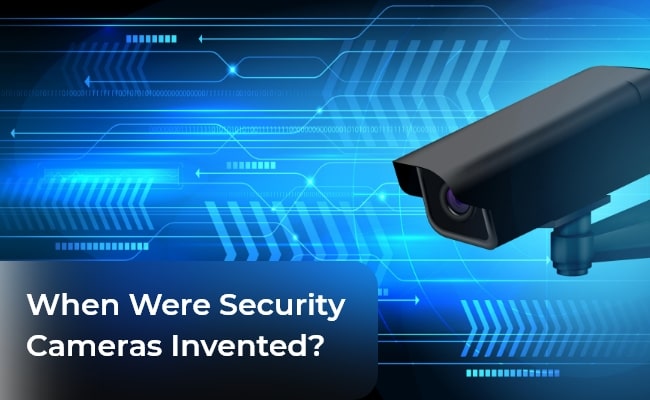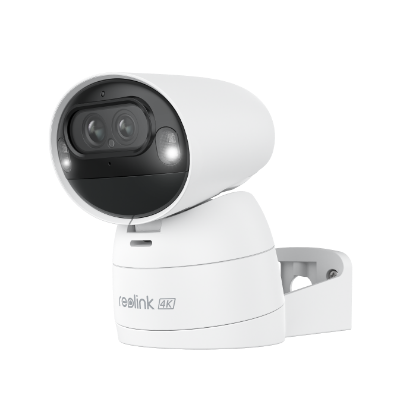When Were Security Cameras Invented? From Past to Present

Security camera is one of the most effective protection tools human beings have ever created. It can safeguard our property by protecting it from burglary and even help us catch perpetrators. However, the first surveillance cameras were not the same as those today. They have undergone many changes that you might not have expected. In this blog, you'll learn the captivating story of when surveillance cameras were invented, who invented the first surveillance cameras, how security cameras have evolved, and what their future is.
When Was the First Security Camera Invented?
The first actual security camera was invented in 1969, This first-ever modern security camera featured four peepholes, a sliding surveillance camera, a monitor, and two-way audio functionality—features that are common in today's modern security cameras.
But before that, there have been some similar concepts. In 1927, Russian scientist Léon Theremin, an inquisitive inventor, wanted to observe objects from afar. So he connected a camera to a TV, and the first surveillance system was born. It was not perfect. The cameras were huge and heavy. There was no way to record because storage devices weren't invented yet.
However, Stalin's Soviet government quickly stopped his work, and it was rumored that they used his invention for their deeds. Theremin did not intentionally try to invent security cameras, but when someone asks, "When was the first security camera invented?" He must be mentioned because he plays a vital role in this story.
Fifteen years later, in 1942, a German engineer named Walter Bruch came up with the first camera used solely for military surveillance. The idea was to keep things safe during rocket launch tests. Nazi scientists wanted to watch these tests from a distance, and this camera helped them do just that. It was like having eyes on the launch without being too close. The United States government saw this idea's usefulness and decided to use it, too. They took a page from Walter Bruch's book and used surveillance cameras.
Who Invented Security Cameras?
But in the 1960s, something groundbreaking happened. Video cassettes were invented. People no longer had to sit all day looking at screens. They had a storage device that could record. And then be played back if needed.
This enabled a brilliant African American inventor, Marie Van Brittany Brown, to invent the first real functioning security camera. However, Marie wasn't just any inventor – she was a nurse living in New York, and her husband happened to be an electronics technician. The whole idea sparked because their neighborhood was facing a high crime rate, and their unpredictable work hours made them more susceptible to potential attacks.
Marie, the nurse, and her husband, the electronics guru, teamed up to tackle the safety concerns in their community. They put their heads together and designed a clever home security camera system. This system consisted of these components: a slide camera, two TV screens, a two-way intercom, and a remote control.
History of Surveillance Camera
Marie laid the foundation for future inventions in home security. The below shows how her idea was built upon throughout history.
The 1970s and 1980s
This was the time when surveillance cameras became popular. They started installing CCTV cameras in ATMs, stores, and banks. They were connected to monitors with cables. Even though they are still used today, they could be better because they are big and draw much attention. Plus, their picture quality could be better.
The 1990s
The 1990s marked the digital age. Someone created the IP camera, which is like magic compared to the old ones. These cameras are way smaller and work without annoying cables – they send what they see to your screens using the Internet.
The 2000s
In the 2000s, AI technology and IoT changed the game. Now, users can peek at security cameras practically anywhere using smart devices and keep an eye on what's happening at home.
Future Trends of Security Cameras
The future of security cameras is bright, and the industry is only getting more significant. Here are some prominent trends in the industry:
AI-Powered Video Analytics
Cameras are now using AI algorithms to analyze data collected in the footage. They can now detect motions and accurately identify a person, vehicle, or animal. For example, if the camera spots suspicious behavior, like an unknown person entering your home, you will be alerted to the possible danger.
IoT Integration
Security Cameras are now being connected to other smart devices. Connecting to smart home automation is simply a necessity. In an unfortunate event of burglary or intrusion, your camera can trigger smart locks to close the door and prevent intruders from entering your home.
Cloud-Based Storage
Cassettes are past, and cloud storage is the future. Storing footage allows you to watch what your camera sees from almost anywhere worldwide as long as you have an internet connection. It also saves you money because you cannot buy local storage devices.
High-Resolution Imaging Technology
High-quality footage is a must in security cameras. Having one is possible if you can see what's happening in and around your house. And that's why high-resolution cameras are the future. You can see the activities around your home with extreme clarity. And you can solve a crime if one does happen. However, only some high-resolution cameras are made equal. These are the most common high-resolution cameras:
- 4K Resolution: A 4K security camera captures about 8 million pixels of video. This means it can display a lot of detail, making recognizing faces, license plates, and finer details in a scene easier.
- 12MP Resolution: A 12MP camera has better quality than a 4 K camera. It captures images with around 12 million pixels, offering a good compromise between detail and data. It's suitable for scenarios where you want clarity without excessive internet data use.
- 16MP Resolution: This is like having a super-detailed photograph. A 16MP camera, for example, Reolink Duo 3 PoE, captures images with about 16 million pixels, providing extremely high detail. It's useful in situations where every nuance needs to be captured, but due to the increased detail, it can use more internet data.
Groundbreaking 16MP Dual-Lens PoE Camera
16MP UHD, Dual-Lens, Motion Track, 180° Wide Viewing Angle, Power over Ethernet, Color Night Vision.
Now, 16MP resolution has been integrated into WiFi security cameras! Check out the new Reolink Duo 3 WiFi for UHD image resolution and an ultra-wide field of view!
Groundbreaking 16MP Dual-Lens WiFi Camera
16MP UHD, Dual-Lens, Motion Track, 180° Wide Viewing Angle, Plug-In WiFi, Color Night Vision.
Latest Security Camera Innovation: Reolink Argus Track
The Reolink Argus Track is a solid choice if you want a top-notch home security camera. It's the ultimate all-rounder when it comes to smart cameras. Thanks to 4K imaging technology, this dual-lens camera can capture high-quality footage with the finest details. The 360-degree field of view with PTZ function covers a wide range, eliminating potential blind spots. You can also use the telephoto lens to zoom in for finer details.
4K Dual-Lens Wi-Fi Solar/Battery Camera
4K 8MP Ultra HD, Auto-Zoom Tracking, Pan, Tilt & 6X Hybrid Zoom, Color Night Vision, Dual-Band Wi-Fi.
FAQs
When did security cameras become common?
Security cameras became more common in the 1970s, with the widespread adoption of CCTV systems for various applications, including public and private security.
Were there security cameras in the 60s?
Yes, the 1960s witnessed significant developments in surveillance technology, including Marie Van Brittany Brown's introduction of the first integrated security system for home use in 1969.
When did security cameras come out?
A lot of people have tried it before. Still, the first real functioning security camera was invented in 1969, marking the emergence of surveillance cameras for commercial and home use.
Conclusion
Security cameras have come a long way since their creation. From the early days with inventors like Léon Theremin and Walter Bruch to Marie Van Brittany Brown's groundbreaking home security camera in 1969, these devices have evolved significantly. In the '70s and '80s, big, clunky cameras appeared, followed by the digital age in the '90s with the introduction of IP cameras. Fast forward to the 2000s, and smart technology revolutionized the game, allowing us to monitor our homes from anywhere.
Looking ahead, the future of security cameras is exciting. They're becoming smarter with AI-powered video analytics, connecting to other devices through IoT, embracing cloud-based storage, and offering high-resolution imaging technology like 4K cameras. So, do you find the journey of security cameras fascinating? Share your thoughts with us in the comment section below, and let's discuss it together!
Search
Subscribe for the Latest Updates
Security insights & offers right into your inbox





























































































































































